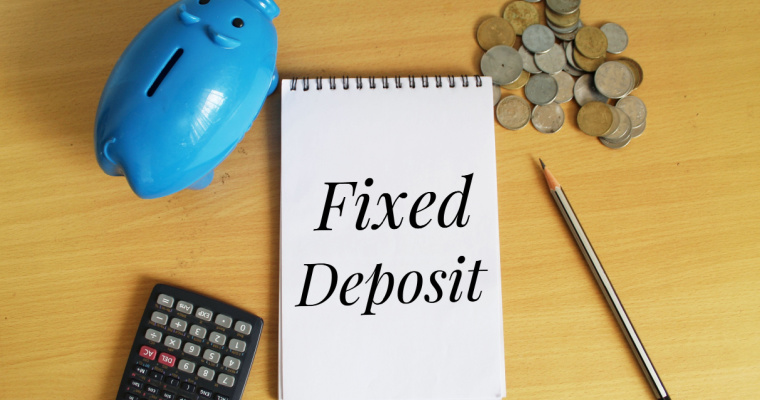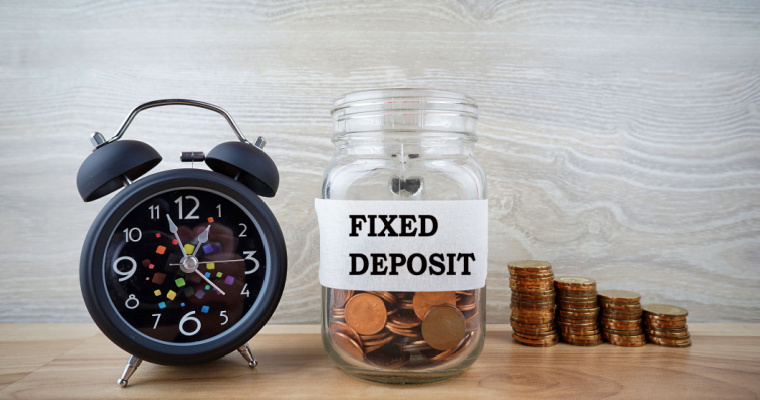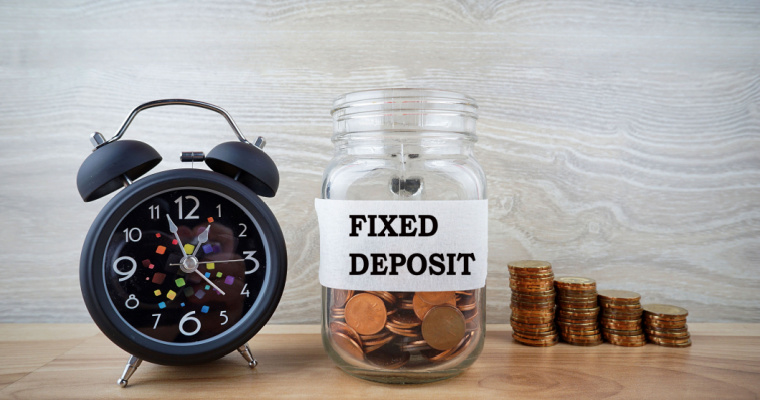Latest SBI FD Interest Rates April 2023

SBI Fixed Deposit (FD) interest rate ranges from 3% to 7% for the general public and 3.50% to 7.50% for senior citizens. Note that SBI senior citizen FD interest rates are 0.50% higher than the standard rate. The deposit tenure ranges from 7 days to 10 years for a normal FD scheme. SBI also offers tax-saving FD that comes with a lock-in period of 5 years with interest rates starting from 6.50% p.a. for the general public and 7% for senior citizens.
There are other SBI FD schemes including Sarvottam (Non-Callable) Term Deposit, Annuity Deposit Scheme, Multi Opinion Deposit, SBI Tax Savings Scheme, Special Term Deposit and Floating Rate Bulk Term Deposit (FRBTD). The bank also has term deposit products dedicated to NRIs, including NRO, NRE, RFC and FCNR (B) fixed deposit schemes.
SBI FD Interest Rates Highlights – April 2023
| Interest Rate | 3% – 7% (for general public) 3% – 7.50% (for senior citizens) |
| Tenure | 7 days – 10 years |
| Minimum Deposit | Rs.1,000 |
| Maximum Deposit | No Upper Limit |
| Lock-in Period | NA (5 years for Tax Saver FD) |
How to Calculate Bank FD Interest Rate?
SBI FD interest rate and maturity amount can be calculated via two methods – the simple interest method and the compound interest method. Simple interest is the interest earned on the principal amount invested at the predetermined interest rate during the investment tenure.
SBI FD Interest Rate Formula – Simple Interest Method
Formula for simple interest calculation is as follows:
Simple Interest = (P * R * T)/100
Where,
- P = Principal amount invested
- R = Rate of interest (%)
- T = Tenure
SBI FD Interest Rate Calculation – Simple Interest Method
Let’s say you have invested Rs.1 lakh for a tenure of 10 years at 7% p.a. Interest rate. In this case, P = Rs.1 lakh, R = 7% and T = 10 years.
- Simple Interest = (1,00,000 * 7 * 10) /100 = Rs.70,000
- Maturity Value = Principal Amount + Simple Interest = Rs.1,00,000 + Rs.70,000
So, at the time of your FD maturity, you will get Rs.1,70,000
The other method is calculation of FD maturity via compound interest. Compound interest is the interest earned on interest. When you earn compound interest on an investment, the interest you earn is added to the principal amount, and the total amount then earns interest again in the next period. This cycle continues, and over time, the interest earned can become significant.
SBI FD Interest Rate Formula – Compound Interest Method
For compound interest calculation, the formula applicable is:
A = P (1+r/n) ^ (n * t)
Where,
- A = Maturity Amount
- P = Principal amount invested
- r = Rate of Interest (in decimals)
- n = number of compounding in a year
- t = number of years
SBI FD Interest Rate Calculation – Compound Interest Method
Let’s say you have invested Rs.1,00,000 for 10 years at an interest rate of 5% p.a. compounded quarterly
In this case, P = Rs.100,000
Interest Rate = 5%
Number of compounding in a year is 4 i.e. 1 every quarter
Number of years of investment is 10 years
A = 1,00,000 (1+0.05/4) ^ (4*10)
A i.e. maturity amount = Rs.1,64,361
Interest amount = Rs.1,64,361 – Rs.1,00,000 = Rs.64,361
Factors that Can Affect SBI Fixed Deposit Rate
Here are some of the factors that can have an impact on SBI FD rates:
1. FD Tenure
Interest rates on FD deposits vary based on tenure. A long-term FD generally has a better interest rate than a short-term FD.
2. Economic Condition
The monetary and fiscal policy along with the prevailing economic conditions of India have a significant impact on the interest rates applicable to fixed deposits.
3. Age
Senior citizens are offered a higher interest rate ranging between 0.25% to 0.75% compared to the normal rate. Senior Citizens having an FD account with SBI can earn 0.50% higher FD interest rate than the normal rate.
4. Renewals
Investors can earn higher interest rates on FDs by opting for an auto-renewal facility provided there’s a hike in interest at the time of renewal.
SBI FD Interest Rate for General Public
SBI FD interest rates differ for term deposits depending on the tenure and amount – below Rs.2 crore and above Rs.2 crore. Deposits above Rs.2 crore are called bulk deposits. For SBI FD deposits below Rs.2 crore, you can earn an interest of up to 7% depending on the tenure. For deposits above Rs.2 crore, you can earn an interest of up to 6.75% depending on the FD tenure. The below table represents SBI FD interest rates in 2023.
| Tenure | Interest on Deposits Below Rs.2 Crore | Interest on Deposits Above Rs.2 Crore |
| 7 days to 45 days | 3% | 4.75% |
| 46 days to 179 days | 4.50% | 5.50% |
| 180 days to 210 days | 5.25% | 6% |
| 211 days to less than 1 year | 5.75% | 6.25% |
| 1 year to less than 2 years | 6.80% | 6.75% |
| 2 years to less than 3 years | 7% | 6.50% |
| 3 years to less than 5 years | 6.50% | 6% |
| 5 years and up to 10 years | 6.50% | 6% |
SBI FD Interest Rate for Senior Citizens
Senior citizens having an FD account with SBI can earn a higher interest rate (0.50% + standard rate) on their deposit. The below table represents the tenure-wise break-up of SBI FD rates for senior citizens.
| Tenure | Interest on Deposits Below Rs.2 Crore | Interest on Deposits Above Rs.2 Crore |
| 7 days to 45 days | 3.50% | 5.25% |
| 46 days to 179 days | 5% | 6% |
| 180 days to 210 days | 5.75% | 6.50% |
| 211 days to less than 1 year | 6.25% | 6.75% |
| 1 year to less than 2 years | 7.30% | 7.25% |
| 2 years to less than 3 years | 7.50% | 7% |
| 3 years to less than 5 years | 7% | 6.50% |
| 5 years and up to 10 years | 7.50%* | 6.50% |
**Note that rates are subject to change without prior notice.
SBI FD Interest Rate for NRI
SBI offers an array of FD or term deposit products for NRIs (Non-resident Indians). Any NRI can deposit their preferred amount in these accounts and earn interest on it. The different types of SBI NRI FD accounts are:
- NRE Fixed Deposit Account
- NRO Fixed Deposit Account
- RFC Account (Resident Foreign Currency Account)
- FCNR Account (Foreign Currency Non-Resident Account)
1. SBI NRO FD Interest Rate
NRO stands for Non-Resident Ordinary, which refers to an account that allows non-resident Indians (NRIs) to manage their Indian earnings and income that they receive while residing outside of India. SBI NRO deposit account allows NRIs to deposit and manage their income earned in India, such as rent, dividends, and pension payments. NRIs can earn up to 7% on their SBI NRO term deposits.
| Tenure | Interest on Deposits Below Rs.2 Crore | Interest on Deposits Above Rs.2 Crore |
| 7 days to 45 days | 3% | 4.75% |
| 46 days to 179 days | 4.50% | 5.50% |
| 180 days to 210 days | 5.25% | 6% |
| 211 days to less than 1 year | 5.75% | 6.25% |
| 1 year to less than 2 years | 6.80% | 6.75% |
| 2 years to less than 3 years | 7% | 6.50% |
| 3 years to less than 5 years | 6.50% | 6% |
| 5 years to 10 years | 6.50% | 6% |
2. SBI NRE FD Interest Rate
NRE stands for Non-Resident External, which refers to an account that allows non-resident Indians (NRIs) to hold their overseas earnings in India. SBI NRE fixed deposit (FD) allows NRIs to deposit their foreign earnings, which are converted into Indian rupees. NRIs can earn up to 7% on their SBI NRE FDs. The table below shows SBI FD rates for NRE.
| Tenure | Interest on Deposits Below Rs.2 Crore | Interest on Deposits Above Rs.2 Crore |
| 1 year to less than 2 years | 6.80% | 6.75% |
| 2 years to less than 3 years | 7% | 6.50% |
| 3 years to less than 5 years | 6.50% | 6% |
| 5 years to 10 years | 6.50% | 6% |
3. SBI FCNR Interest Rates
FCNR or Foreign Currency Non-Resident refers to an account that allows NRIs to hold their foreign currency deposits in India. SBI FCNR deposit account helps NRIs deposit their foreign earnings in a foreign currency, which is then converted into Indian rupees at the prevailing exchange rate. Account holders can earn up to 5.25% interest on their SBI FCNR deposits. The tenure ranges from 1 year (minimum) to 5 years (maximum). The table below shows SBI fixed deposit rate for FCNR deposits.
| Tenure | Currency | |||||
| USD | GBP | EURO | CAD | AUD | JPY | |
| 1 year | 5.25% | 4.50% | 1.50% | 4.30% | 3.60% | 0.02% |
| Above 1 year to less than 2 years | 5.25% | 4.50% | 1.50% | 4.30% | 3.60% | 0.02% |
| 2 years to less than 3 years | 4.20% | 2.35% | 1.50% | 4.10% | 3.50% | 0.05% |
| 3 years to less than 4 years | 4.05% | 2.45% | 1.50% | 3.85% | 3% | 0.05% |
| 4 years to less than 5 years | 4.10% | 2.45% | 1.50% | 3.70% | 3% | 0.05% |
| 5 years | 4.15% | 2.45% | 1.50% | 3.60% | 3% | 0.05% |
4. SBI RFC Interest Rate
SBI RFC or Resident Foreign Currency account allows resident Indians who have returned from abroad to maintain their foreign currency earnings in India. The account can be opened in various foreign currencies, such as US dollars, British pounds, and Euros. The minimum deposit tenure is 1 year and the maximum is 3 years. Depositors can earn up to 5.25% interest on their SBI RFC deposits.
| Tenure | Currency | ||
| USD | GBP | EURO | |
| 1 year to less than 2 years | 5.25% | 4.50% | 1.50% |
| 2 years to less than 3 years | 4.20% | 2.35% | 1.50% |
| 3 years | 4.05% | 2.45% | 1.50% |
SBI Vs Other Banks FD Interest Rates
We have considered deposits below Rs.2 crore based on the common threshold in India. The upper limit for interest rate includes senior citizen SBI senior citizen FD rates.
| Bank Name | Tenure | Interest Rate |
| HDFC Fixed Deposit | 7 days to 10 years | 3% to 7.75% |
| ICICI Fixed Deposit | 7 days to 10 years | 3% to 7.60% |
| Axis Bank Fixed Deposit | 7 days to 10 years | 3% to 7.26% |
| Central Bank of India Fixed Deposit | 7 days – 10 years | 4% – 6.75% |
| Canara Bank Fixed Deposit | 7 days – 10 years | 4% – 7.75%* |
| IndusInd Fixed Deposit | 7 days to 5 years and above | 3.50% to 8.25% |
| Bank of Baroda Fixed Deposit | 7 days to 10 years | 3% to 7.55% |
| Bank of India Fixed Deposit | 7 days to 10 years | 3% to 7.80% |
| Union Bank Fixed Deposit | 7 days to 10 years | 3% to 8.05% |
| Indian Overseas Bank | 7 days to 10 years | 4.30% to 7.75% |
| Kotak Bank Fixed Deposit | 7 days to 10 years | 2.75% to 7.70% |
| IDFC Bank Fixed Deposit | 7 days to 10 years | 3.50% to 8.25% |
| Yes Bank Fixed Deposit | 7 days to 10 years | 3.25% to 8.25% |
| Post office Fixed Deposit/Time Deposit | 1 year to 5 years | 6.6% to 7% |
| Bandhan Bank Fixed Deposit | 7 days to 10 years | 3.75% to 8.50% |
| Punjab and Sind Bank Fixed Deposit | 7 days to 10 years | 2.80% – 7.60% |
Features and Benefits of SBI Fixed Deposit
Here are some of the features and benefits of SBI FD:
- Minimum period of deposit is 7 days (5 years for Tax Saver FD)
- Maximum tenure is 10 days
- Minimum deposit required is Rs.10,000
- There’s no upper limit for maximum deposit
- Interest on a Term Deposit is payable to the depositor quarterly from the date of issue or at maturity along with the principal
- Tax deduction benefit under Section 80C is applicable only for SBI Tax Saver FD scheme
- TDS is applicable as per IT Rules
Also Read
What are the Different Types of FD Schemes Offered by the Bank?
SBI offers various fixed deposit schemes for Indian residents and NRIs. Each scheme is designed to serve a specific purpose. The types of FD schemes offered by the bank are:
- SBI Fixed Deposit
- SBI Sarvottam
- SBI Annuity Deposit Scheme
- SBI Multi Option Deposit
- SBI Tax Savings Scheme – 2006
- SBI Special Term Deposit
- SBI Floating Rate Bulk Term Deposit
- SBI NRE Deposit
- SBI NRO Deposit
- SBI FCNR Deposit
- SBI RFC Deposit
- SBI Amrit Kalash
Details of SBI FD Schemes 2023
1. SBI Fixed Deposit
- Minimum Deposit: Rs.1,000
- Maximum Deposit: No Upper Limit
- Tenure: 7 days to 10 years
- Interest Rate: 3% to 7.50%
- Eligibility Criteria: Indian resident
2. SBI Sarvottam
- Minimum Deposit: Rs.15 lakh
- Maximum Deposit: Rs.5 crore
- Tenure: 1 year to 2 years
- Interest Rate: 6.90% to 7.90%
- Eligibility Criteria: Indian resident
3. SBI Annuity Deposit Scheme
- Minimum Deposit: Rs.1,000
- Maximum Deposit: No Upper Limit
- Tenure: 36, 60, 84 or 120 months
- Interest Rate: 3% to 7.50%
- Eligibility Criteria: Indian residents, including minors
4. SBI Multi Option Deposit
- Minimum Deposit: Rs.10,000
- Maximum Deposit: No Upper Limit
- Tenure: 1 to 5 years
- Interest Rate: 3% to 7.50%
- Eligibility Criteria: Indian resident
5. SBI Tax Savings Scheme, 2006
- Minimum Deposit: Rs.1,000
- Maximum Deposit: Rs.1.5 lakh
- Tenure: 5 years to 10 years
- Interest Rate: 6% to 7.50%
- Lock-in Period: 5 years
6. SBI Special Term Deposit
- Minimum Deposit: Rs.1,000
- Maximum Deposit: No Upper Limit
- Tenure: 6 months to 10 years
- Interest Rate: 3% to 7.50%
- Loan Facility Available
7. SBI Floating Rate Bulk Term Deposit
- Minimum Deposit: Rs.2 crore
- Maximum Deposit: No Upper Limit
- Tenure: 91 days to 3 years
- Interest Rate: 4.75% to 6.50%
- Eligibility Criteria: Indian residents and NRIs
- Loan/Overdraft facility would be available up to 90% of FRBTD amount
8. SBI NRE Deposit
- Minimum Deposit: Rs.1,000
- Maximum Deposit: No Upper Limit
- Tenure: 1 year to 10 years
- Interest Rate: 6.50% to 7%
- Eligibility Criteria: NRIs
9. SBI NRO Deposit
- Minimum Deposit: Rs.1,000
- Maximum Deposit: No Upper Limit
- Tenure: 7 days to 10 years
- Interest Rate: 3% to 7.10%
- Eligibility Criteria: NRIs
10. SBI FCNR Deposit
- Minimum Deposit: USD 1,000 or equivalent
- Maximum Deposit: No Upper Limit
- Tenure: 1 year to 5 years
- Interest Rate: 1.50% to 5.25%
- Eligibility Criteria: NRIs
11. SBI RFC Deposit
- Minimum Deposit: USD 1000, GBP 1000 or EURO 1000
- Maximum Deposit: No Upper Limit
- Tenure: 1 year to 3 years
- Interest Rate: 1.50% to 5.25%
- Eligibility Criteria: NRIs
12. SBI Amrit Kalash
- Maximum Amount: No Upper Limit
- Minimum Amount: Rs.1,000
- Interest Rate: 7.10% to 7.60%
- Tenure: 400 days
- Loan Facility: Available
- Eligibility: Indian Residents and NRIs
How to Invest in SBI Fixed Deposit?
Follow the steps below to open an SBI FD account:
- Step 1: Log in to your SBI net banking facility using your login ID and password
- Step 2: Select e-fixed deposit tab on the top menu
- Step 3: You will be able to see three options. Select the first option and click on ‘Proceed’
- Step 4: Select the account from which you want to send your FD amount to be debited
- Step 5: Fill in your SBI FD investment amount and tenure
- Step 6: Once you have selected the tenure, choose your FD maturity date
- Step 7: You need to select from auto-renew principal and interest, auto-renew principal and repay interest, repay principal and interest
- Step 8: Accept ‘terms and conditions’ and click on ‘Submit’ to open your SBI FD
Documents Required to Open SBI FD
To open an SBI FD account, you may need the following documents:
- Identity Proof: PAN card, Aadhaar card, voter ID, passport, or driving licence
- Address Proof: Passport, Aadhaar card, bank statement with a cheque, or voter ID
- Date of Birth Proof: PAN card, Aadhaar card, voter ID, or service discharge certificate
Eligibility to Open SBI FD
You may need to meet the following eligibility criteria to open SBI FD:
- Indian resident individuals holding a single account with SBI
- Two Indian resident individuals holding account ownership jointly
- Karta of Hindu Undivided Families (HUFs)
- Minors with parents/guardians’ consent or solely
- Firms and companies
- Local bodies and any government department
Taxation on SBI FD
- The interest earned on FDs is considered as “income from other sources” and is subject to taxation as per the individual’s income tax slab
- Banks are required to deduct TDS every year on the interest earned on FDs if the interest amount exceeds Rs.40,000 per financial year (Rs.50,000 for senior citizens)
- If an individual withdraws their FD before the maturity date, the interest earned on such premature withdrawal is also subject to taxation as per their income tax slab
- Form 15G/15H can be submitted by the depositor for exemption from tax deduction as per IT Rules
However, if you have a tax-saving FD account with SBI, you can claim tax deduction benefits of up to Rs.1.5 lakh under Section 80C of the Income Tax Act. Note that SBI tax saving FD comes with a lock-in period of 5 years.
Loan Against SBI FD Scheme
If you’re in need of urgent cash and looking for an alternative to personal loans, you can take a loan against your SBI FD account. Currently, you can take 95% of the value of your fixed deposit as a loan. The interest rate is 1% above the relative FD rate. Let’s look into the key highlights of loan against SBI FD:
- Get up to 95% of the value of your fixed deposit
- No processing charges
- No prepayment penalties
- Minimum amount of loan: Rs.5,000
- Maximum amount of loan: Rs.5 crore
- Interest rate is 1% above the relative FD rate
- Loan against SBI FD is considered a demand loan or overdraft
However, you would need to be eligible to apply for a loan against FD.
Final Word
Make sure to go through SBI’s fine print to understand the nitty-gritty of their FD scheme in detail. If you’re a senior citizen, you’re eligible to get 0.5% higher interest rate than the standard rate. However, if you’re planning to withdraw your SBI FD before maturity, consider the penalty charges before doing so.
Investing in FDs gives you assured returns albeit at a lower interest rate. But to beat the rising inflation, you need to find an alternate avenue. Consider investing in Navi Mutual Fund schemes maybe? We have schemes for every investor. Wary of the market? You can mitigate the market chaos by investing with just Rs.10!
FAQs
The minimum deposit required to open an SBI fixed deposit account is Rs.1,000. There’s no upper limit as such. But note that any deposit of more than Rs.2 crore is considered as bulk deposits. The interest rates vary and are usually lower than normal FD deposits – deposits below Rs.2 crore.
SBI offers an interest rate of 6.80% (for general depositors excluding senior citizens) for any deposit made for 1 year. So, if you have invested Rs.1 lakh for a maturity period of 1 year, your estimated returns would be Rs.6,975. So, the total amount you would receive upon maturity would be Rs.1,06,975.
If your income is below the taxable limit, you would receive FD interest in its entirety without TDS. However, you will have to file either Form 15G or 15H depending on your age. A senior citizen must file Form 15G. On the other hand, other individual taxpayers must file Form 15H.
SBI offers separate time deposits or FD accounts for NRIs. These include – NRE, NRO, FCNR and RFC accounts. Each account serves a specific purpose and the returns also vary depending on that.
As per SBI, for FDs up to Rs.5 lakh, the penalty for premature withdrawal will be 0.50%. For FDs above Rs.5 lakh, the applicable penalty will be 1%. The penalty charges would be flat across all tenures.
You can get tax deduction benefits up to Rs.1.5 lakh under Section 80C of the I-T act only on SBI tax-saving scheme. However, the lock-in period is 5 years, meaning you cannot withdraw the amount before the maturity period of 5 years.
The minimum FD rate is 3% and the maximum is 7.50%. The interest rate varies depending on the FD tenure. For Amrit Kalash scheme, you can get up to 7.60% interest rate on your 400 days’ deposit.
Disclaimer
This article is solely for educational purposes. Navi doesn't take any responsibility for the information or claims made in the blog.

Customer’s Feedback
No comments found.Latest Post Office FD Interest Rate April 2023
Post office FD interest rates are currently in the range of 6.8% to 7.5% for the quarter ending Jun... Read More »Latest South Indian Bank FD Interest Rate April 2023
The South Indian Bank FD rate varies between 2.65% and 7.55% depending on the amount deposited, the... Read More »Latest IDBI Bank FD Interest Rate April 2023
IDBI Bank FD interest rates range between 3% and 6.75% for the general public and 3.5% and 7.25% p.... Read More »Latest UCO Bank FD Interest Rate April 2023
UCO Bank FD rates range from 2.90% to 7.20% for the general public and 3.15% to 7.70% for senior ci... Read More »Latest Bandhan Bank FD Interest Rate April 2023
Bandhan Bank FD interest rates range from 3% to 8% for the general public and 3.75% to 8.50% for se... Read More »Latest YES Bank FD Interest Rate April 2023
YES Bank FD rates are currently in the range of 3.25% to 7.5% for regular investors and 3.75% to 8%... Read More »Latest Punjab National Bank FD Interest Rate April 2023
Punjab National Bank or PNB fixed deposit interest rates are currently in the range of 3.50% to 7.2... Read More »Latest IDFC First Bank FD Interest Rate April 2023
IDFC First Bank FD rates are among the most competitive in the market and currently range from 3.50... Read More »Latest Karnataka Bank FD Interest Rate April 2023
Karnataka Bank FD rates can range from 4.5% to 7.30% for the general public and 4.90% to 7.80% for ... Read More »Latest Citibank FD Interest Rate April 2023
Citibank FD rates are currently in the range of 3.50% to 7.26% for normal investors, and up to 8.01... Read More »Latest RBL Bank FD Interest Rate April 2023
Ratnakar Bank Limited (RBL) FD rates range from 3.5% to 7.8% for the general public and 4% to 8.30%... Read More »Latest HSBC Bank FD Interest Rate April 2023
HSBC FD rates range from 2.85% to 7.50% for general depositors and 3.35% to 8% for senior citizens.... Read More »Top 10 Chit Fund Schemes in India in 2023
Chit funds are one of the most popular return-generating saving schemes in India. It is a financial... Read More »10 Best Gold ETFs in India to Invest in April 2023
Gold ETFs or Gold Exchange Traded Funds are passively managed funds that track the price of physica... Read More »10 Best Demat Accounts in India for Beginners in 2023
Creation of Demat accounts revolutionised the way trades were conducted at the stock exchanges. It... Read More »20 Best Index Funds to Invest in India in April 2023
What is an Index Fund? An index fund is a type of mutual fund or exchange-traded fund (ETF) that... Read More »Best Arbitrage Mutual Funds to Invest in India in April 2023
Arbitrage funds are hybrid mutual fund schemes that aim to make low-risk profits by buying and sell... Read More »10 Best SIP Plans in India to Invest in April 2023
What is SIP? SIP or Systematic Investment Plan is a method of investing a fixed amount in ... Read More »10 Best Corporate Bond Funds in India to Invest in April 2023
Corporate bond funds are debt funds that invest at least 80% of the investment corpus in companies ... Read More »10 Best Bank for Savings Account in India [Highest Interest Rate 2023]
Savings account is a type of financial instrument offered by several banks. It lets you safely depo... Read More »
































